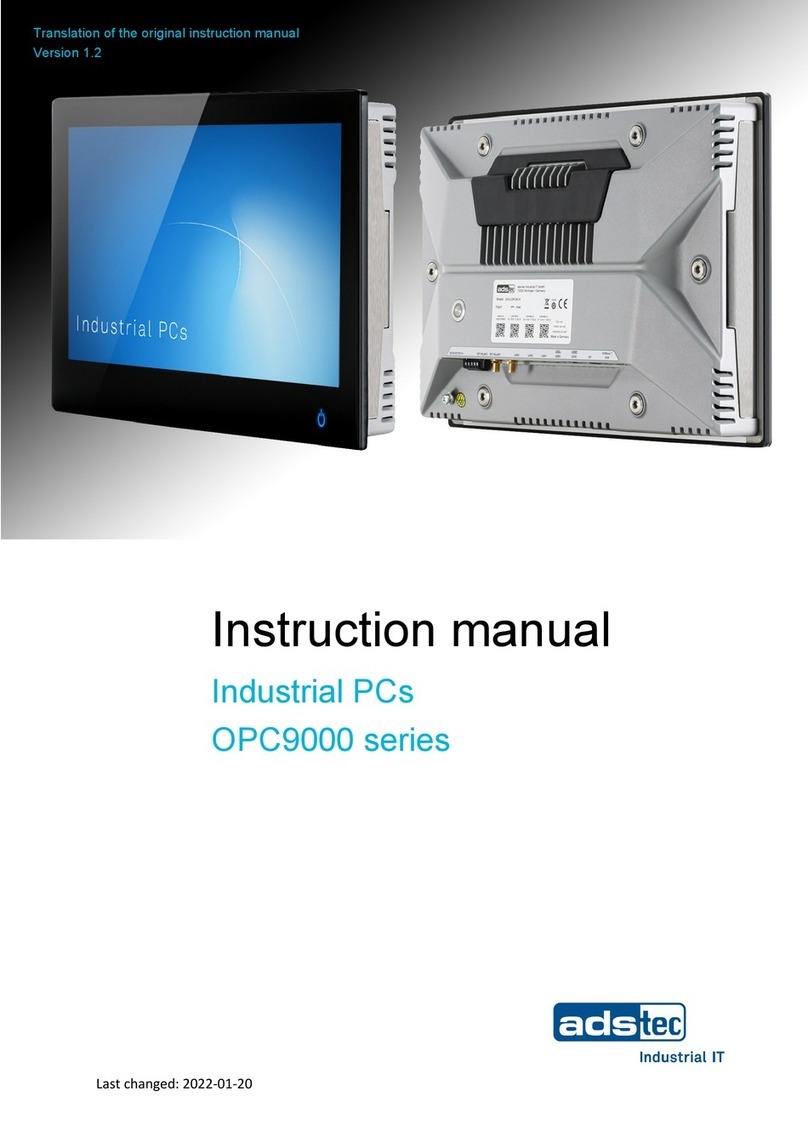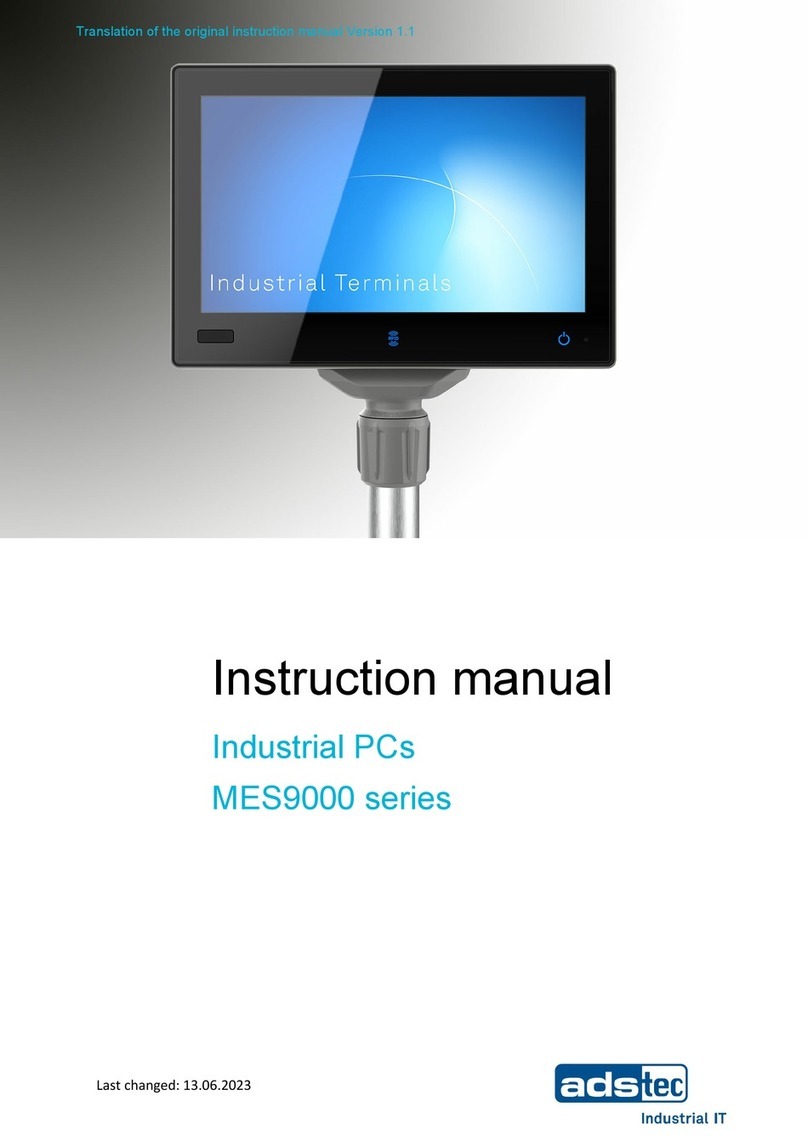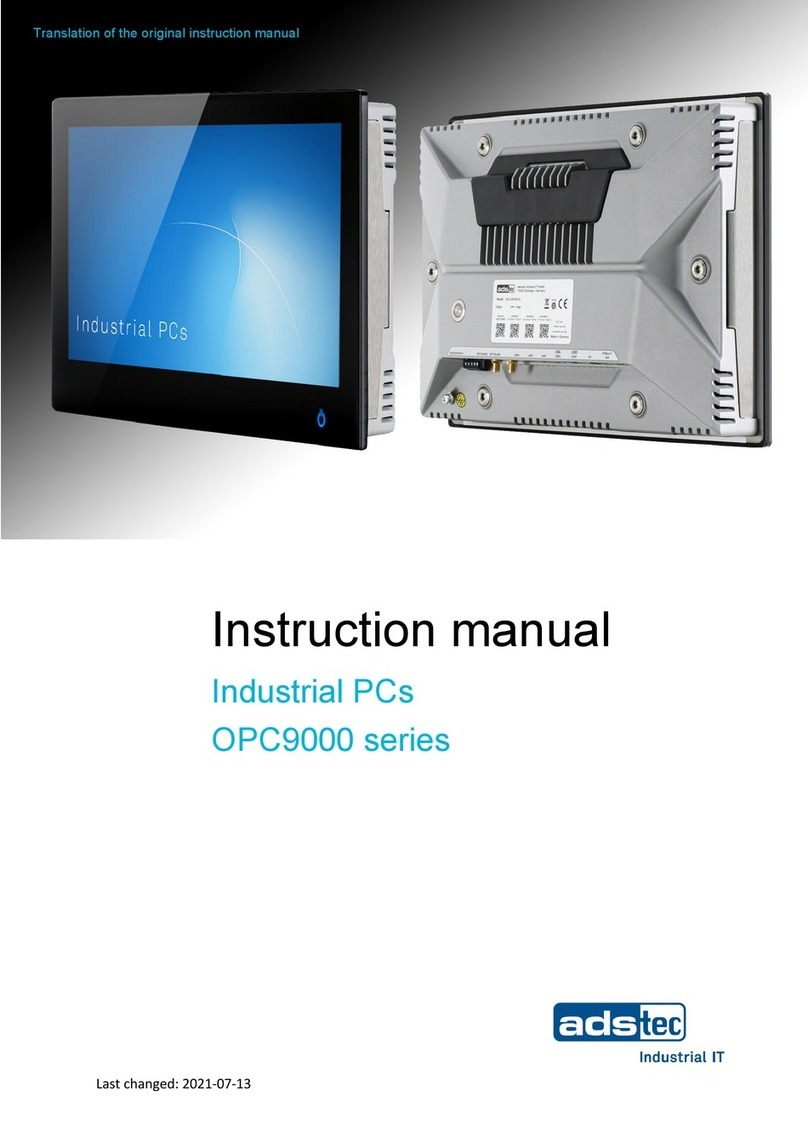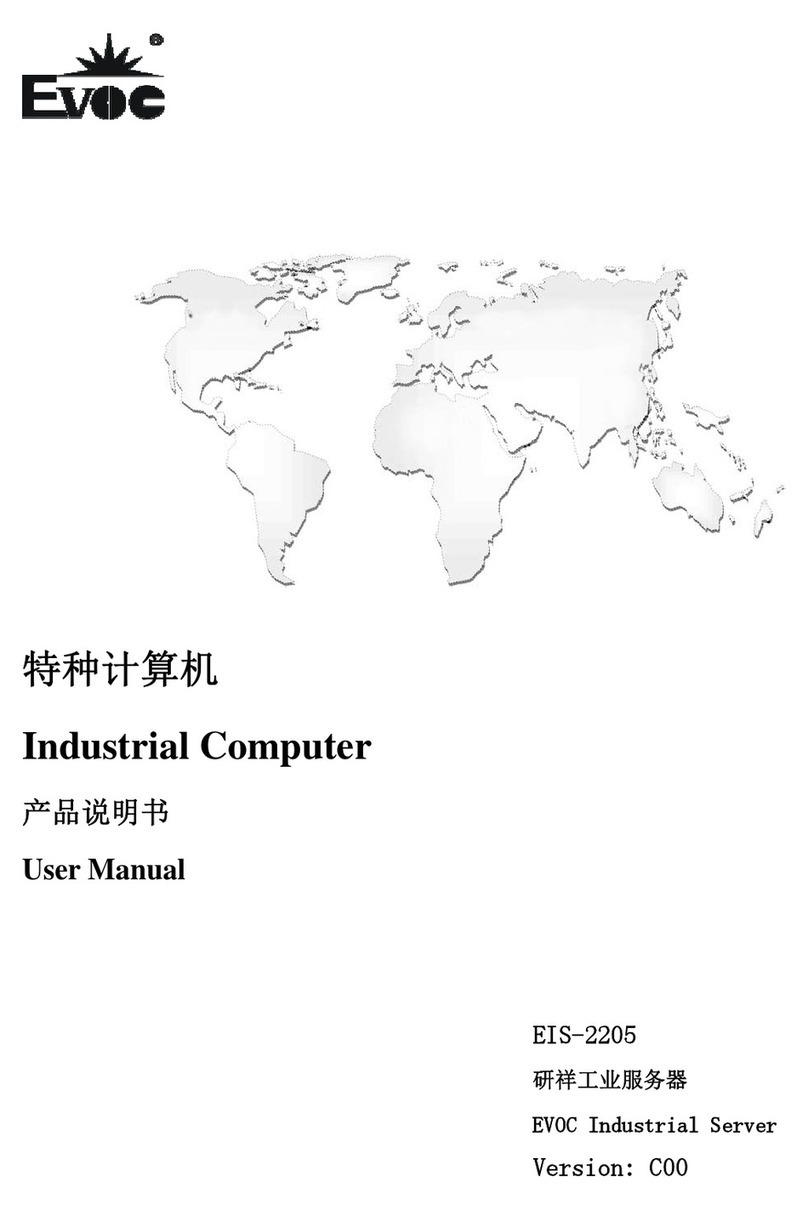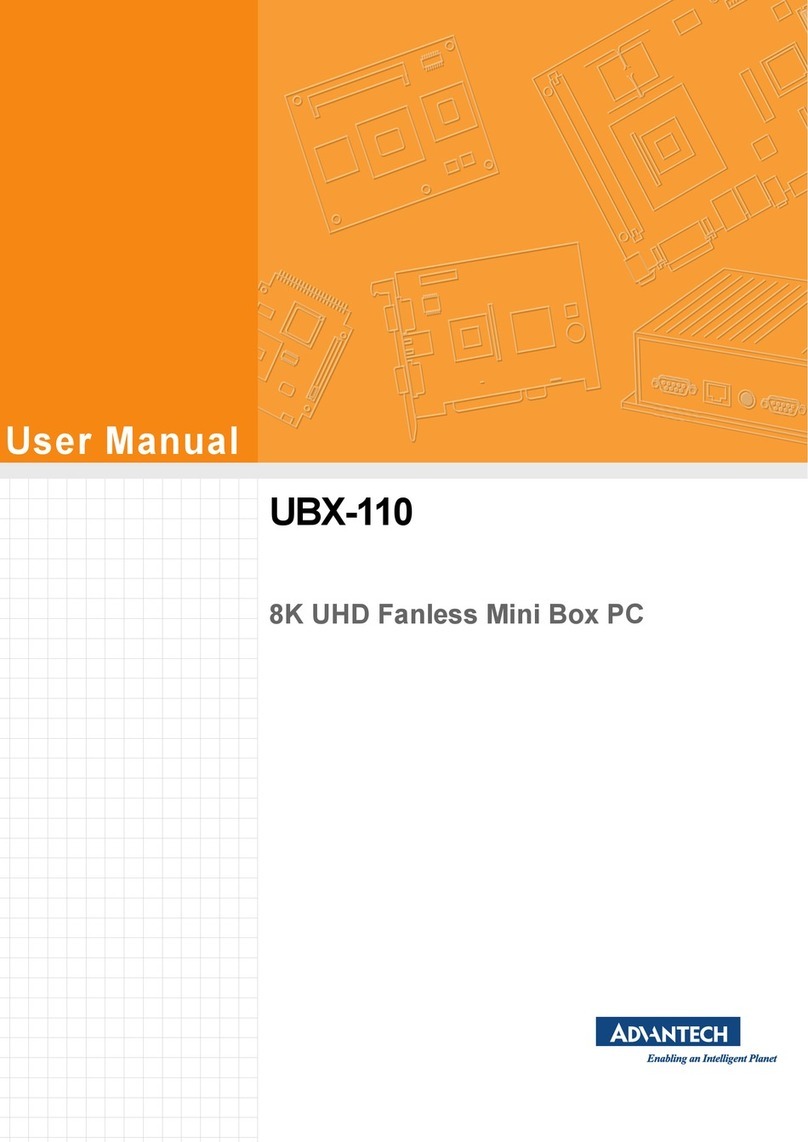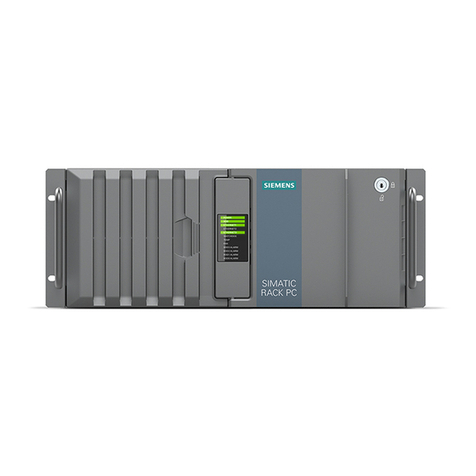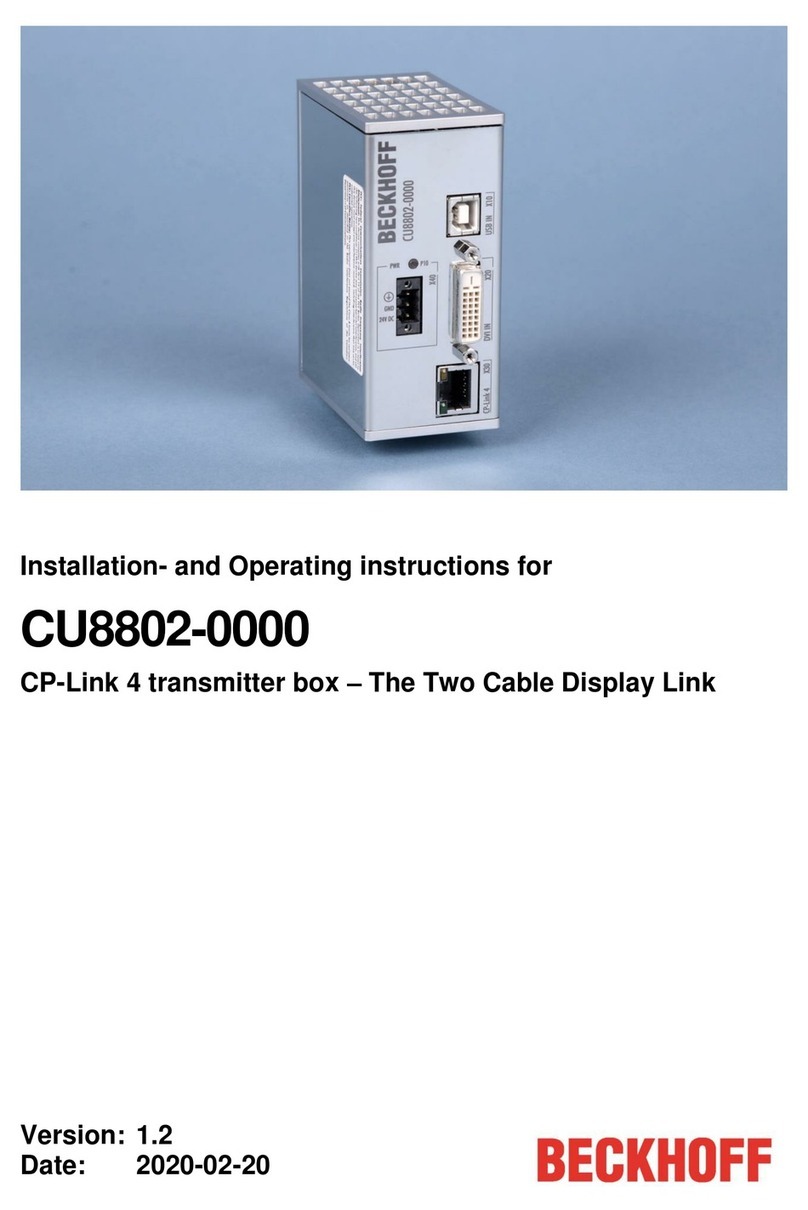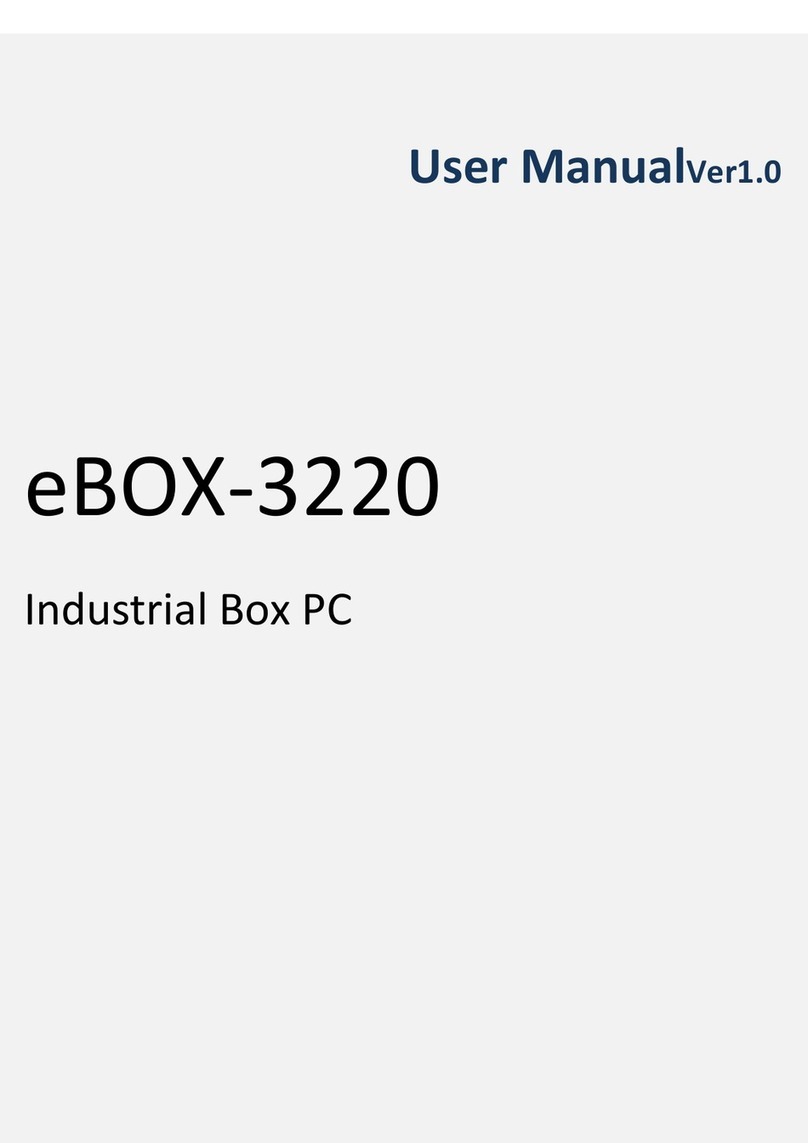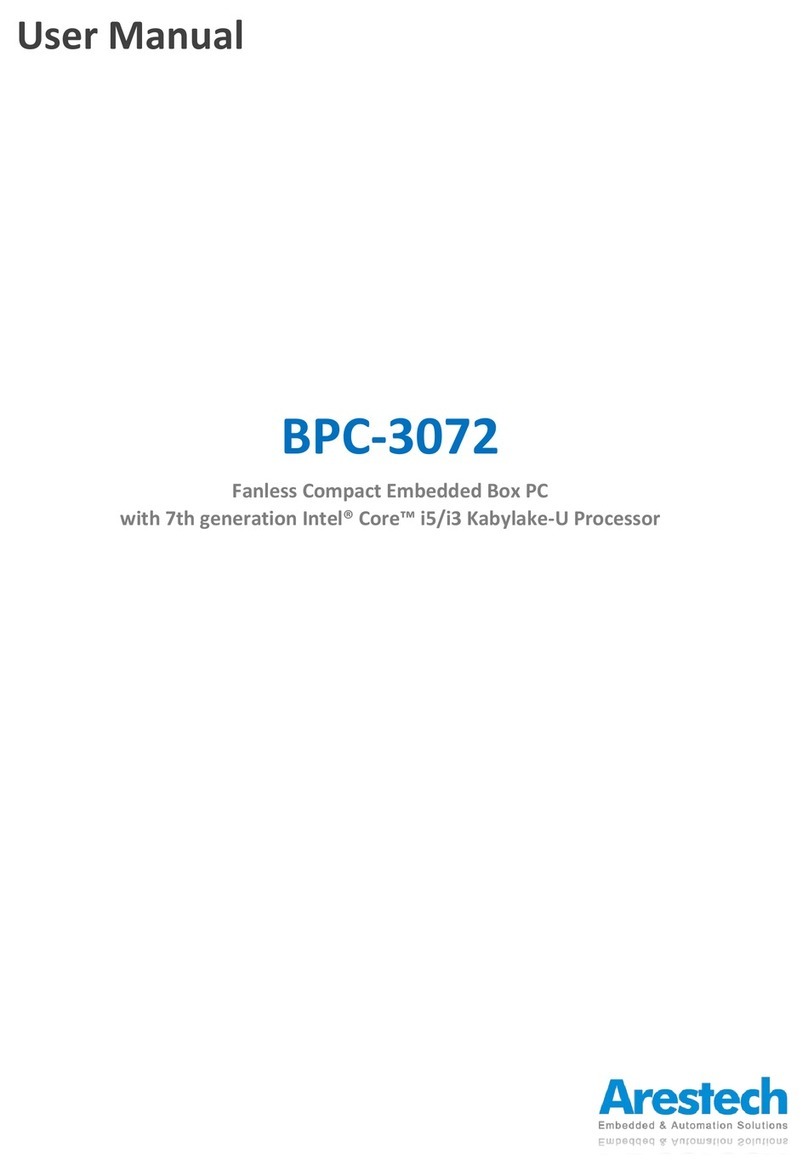adstec IRF3000 Series User manual

Schnellstartanleitung IRF3000 Serie
DZ-HAND-91096-0/A 2022-06-21 v1.0 © ads-tec Industrial IT GmbH • Heinrich-Hertz-Str. 1 • 72622 Nürtingen • Germany
1. Sicherheit
ACHTUNG
Personen- und Sachschäden durch unsachgemäße
Handhabung
Montage- und Servicearbeiten am Gerät sind nur in
gesichertem und spannungsfreiem Zustand erlaubt!
Hinweis:
Achten Sie bei der Handhabung elektrostatisch
gefährdeter Bauteile auf die relevanten
Sicherheitsmaßnahmen gemäß DIN EN 61340-5-1/-2.
1 x Industrial Router & Firewall Typ IRF3xxx
1 x 4-poliger Stecker für Spannungsversorgung
1 x 3-poliger Stecker für Modbus-RTU
1 x 4-poliger Stecker (grau) für digitale E/As Nr. 2
Nur bei IRF38: 1 x 8-poliger Stecker für digitale E/As Nr. 3…5
1 x Schnellstartanleitung (dieses Dokument)
Optional: 2 x Mobilfunkantenne
Optionales Zubehör: 1 x VESA-Adapterplatte
Verwendet werden können SIM-Karten und Smartcards (SC) im
Format ID-000 gemäß ISO 7816 (25x15 mm).
Die SIM-Karte für den Mobilfunk muss im unteren Steckplatz (SIM1)
gesteckt werden.
Die Smartcard ist für ein Backup der Konfigurationsdaten oder für
die Verbindung zu Big-LinX vorgesehen und muss im oberen
Steckplatz (SC/SIM2) gesteckt werden.
In den linken Steckplatz können Sie eine microSD-Karte mit bis zu
2048 GB als Speichererweiterung stecken.
•Stecken Sie die Karten jeweils in der gezeigten Ausrichtung:
4.1 An Hutschiene anbringen
1. Setzen Sie die IRF von unten schräg an der Hutschiene an (1).
2. Ziehen Sie die Hutschienenverriegelung (2) mit einem Schraubendreher nach
oben, drücken das Gerät oben an die Hutschiene und entfernen den
Schraubendreher.
3. Die Hutschienenverriegelung springt in ihre Ausgangsposition zurück.
4. Überprüfen Sie den Sitz der IRF an der Hutschiene.
4.2 Von Hutschiene lösen
Um die IRF von der Hutschiene zu lösen, ziehen Sie die Hutschienen-
verriegelung (2) mit einem Schraubendreher nach oben und kippen das Gerät
nach schräg unten weg.
4.3 Optionales Zubehör: VESA-Adapterplatte anschrauben
Die Halteplatte mit den mitgelieferten Schrauben direkt auf das Geräteetikett
schrauben. Die Positionen der Schraublöcher sind mit Zielkreuzen ( ) auf dem
Etikett gekennzeichnet.
4.4 Optional: Antennen anbringen
Schrauben Sie die Mobilfunkantennen direkt oder
über ein SMA-Verlängerungskabel auf die
Antennenanschlüsse (WWAN AUX/MAIN).
Nur IRF38xx: GNSS = Anschluss für eine GPS-Antenne
5.1 Modbus-RTU (RS-485) (galvanisch getrennt)
Elektrische Busbelastung: 1/8 Einheit (Unit load), Impedanz: 96 kΩ).
GND Bezugspotenzial (Common) für die Datensignale
D- Invertiertes Datensignal
D+ Nicht-invertiertes Datensignal
5.2 Digitale E/A Nr. 2 (galvanisch getrennt)
V+ Spannungsversorgung +24 VDC ± 20 %
DI2 Digitaler Eingang Nr. 2
DO2 Digitaler Ausgang Nr. 2, max. 0,5 A
GND Bezugspotenzial
5.3 Spannungsversorgung des Geräts und DI Nr. 1
DI Digitaler Eingang Nr. 1: +24 VDC ± 20 %
Bezugspotenzial ist 0V des Geräts
FE Funktionserde (erforderlich für EMV)
0V Bezugspotenzial
V+ Versorgungsspannung +24 VDC ± 20 %
5.4 Nur IRF38xx: Digitale E/As 3…5 (galvanisch getrennt)
V+ Versorgungsspannung +10…30 VDC
DIx Digitaler Eingang Nr. 3…5
DOx Digitaler Ausgang Nr. 3…5, zusammen max. 1,5 A
GND Bezugspotenzial
6.1 IRF an einen PC anschließen
Für die Erstinbetriebnahme muss das Gerät an einen PC angeschlossen werden.
Verbinden Sie den Anschluss ETH1 der IRF mithilfe eines Patchkabels mit Ihrem PC.
6.2 Konfiguration des LAN-Netzwerkadapters Ihres PCs
Öffnen Sie die Eigenschaften-Karte des verwendeten Netzwerkadapters und tragen Folgendes ein:
IP-Adresse: 192.168.0.100 Subnetzmaske: 255.255.255.0
Die letzte Zahl der IP-Adresse muss eine Zahl zwischen 1 und 253 sein, z.B. „100“.
6.3 Aufruf des Webinterface der IRF
Um das Webinterface des Geräts zu öffnen, starten Sie Ihren Web-Browser.
Geben Sie folgende IP-Adresse in die Adresszeile des Browsers ein:
http://192.168.0.254
Bestätigen Sie Ihre Eingabe. Geben Sie die Default-Zugangsdaten ein:
Benutzername: admin Passwort: admin
Das Webinterface des Geräts öffnet sich. Folgen Sie den Anweisungen des Inbetriebnahme-Assistenten.
Weitere Informationen sowie Zubehör finden Sie auf unserer Website
www.ads-tec.com
⌖
6. Erstinbetriebnahme
4. Montage
5. Installation
2. Lieferumfang
3. Optional: SIM-Karte / Smartcard / microSD einlegen

Quick Start Guide IRF3000 series
DZ-HAND-91096-0/A 2022-06-21 v1.0 © ads-tec Industrial IT GmbH • Heinrich-Hertz-Str. 1 • 72622 Nürtingen • Germany
1. Safety
ATTENTION
Personal injuries and damage to property through
improper use
All installation and service work performed on the
device must be performed only under safe, secure and
de-energised conditions!
Note:
Always adhere to the safety measures applicable
when handling components at risk of being damaged
by electrostatic discharges in accordance with
EN 61340-5-1/-2.
1 x Industrial router and firewall, type IRF3xxx
1 x 4-pin plug for power supply
1 x 3-pin plug for Modbus RTU
1 x 4-pin plug (grey) for digital I/O #2
Only with IRF38: 1 x 8-pin plug for digital I/Os #3…5
1 x Quick-start guide (this document)
Optional: 2 x Mobile communications antenna
Optional accessory: 1 x VESA holder
SIM cards and smart cards (SC) in the ID-000 format as defined
in ISO 7816 (25x15 mm) can be used.
The SIM card for mobile communications must be inserted into the
bottom slot (SIM1).
The smart card is intended for backing up the configuration data
or for connecting to Big-LinX and must be inserted into the top slot
(SC/SIM2).
You can insert a microSD card with up to 2048 GB as a memory
expansion into the left slot.
•Insert the cards the right way round as shown in the figure.
4.1 Attaching to top-hat rail
1. Position the IRF on the top-hat rail from below at an angle (1).
2. Pull the top-hat rail locking mechanism (2) upwards using a screwdriver, push
the device onto the upper side of the top-hat rail and remove the screwdriver.
3. The top-hat rail locking mechanism springs back to its original position.
4. Check that the IRF is seated securely on the top-hat rail.
4.2 Detaching from top-hat rail
To detach the IRF from the top-hat rail, pull the top-hat rail locking mechanism
(2) upwards using a screwdriver and remove the device downwards at an angle.
4.3 Optional accessory: Attaching the VESA holder
Screw the mounting plate directly onto the device label using the screws provided.
The positions of the screw holes are marked with target crosses ( ) on the label.
4.3 Optional: Attaching antennas
Screw the mobile communications antennas to
the antenna connections directly or via
SMA extension cables.
Only with IRF38: GNSS = connection for a GPS antenna
5.1 Modbus RTU (RS-485) (electrically isolated)
Electrical bus load: 1/8 unit load; impedance: 96 kΩ.
GND Reference potential (common) for the data signals
D- Inverted data signal
D+ Non-inverted data signal
5.2 Digital I/O #2 (electrically isolated)
V+ Supply voltage +24 VDC ± 20 %
DI2 Digital input #2
DO2 Digital output #2, max. 0.5 A
GND Reference potential
5.3 Power supply of the device and digital input #1
DI Digital Input #1: +24 VDC ± 20 %
Reference potential is 0V of the device.
FE Functional earth (required for EMC)
0V Reference potential
V+ Supply voltage +24 VDC ± 20 %
5.4 Only IRF38xx: Digital I/Os 3…5 (electrically isolated)
V+ Supply voltage +10…30 VDC
DIx Digital inputs #3…5
DOx Digital outputs #3…5, together max. 1.5 A
GND Reference potential
6.1 Connecting IRF to PC
During initial setup, the IRF must be connected to a PC. Connect the connection ETH1 of the IRF to
your PC using a patch cable.
6.2 Configuring LAN network adapter of your PC
Open the Properties of the used network adapter and enter the following parameters:
IP address: 192.168.0.100 Subnet mask: 255.255.255.0
The last number of the IP address must be a number between 1 and 255, e.g. "100".
6.3 Calling web interface of IRF
To access and open the device web interface, start up your web browser.
Enter the following IP address in the address field of the browser:
http://192.168.0.254
Confirm your entry. Then, enter the default log-in details:
User name: admin Password: admin
The web interface of the device opens. Follow the instructions of the setup wizard.
Further information as well as accessories can be found on our website
www.ads-tec.de
2. Scope of delivery
⌖
4. Assembly
3. Optional: Inserting SIM card / smart card / microSD
5. Installation
6. Commissioning
Table of contents
Languages:
Other adstec Industrial PC manuals
Popular Industrial PC manuals by other brands
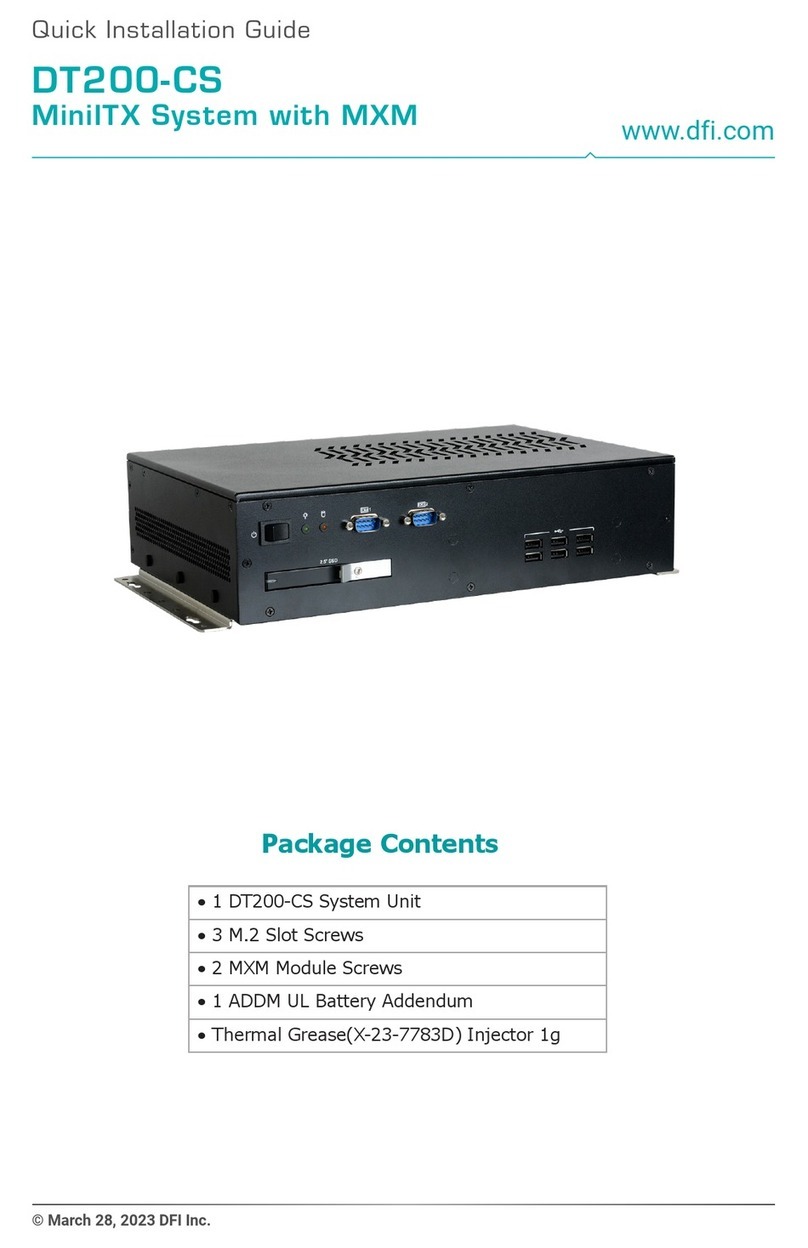
DFI
DFI DT200-CS Quick installation guide
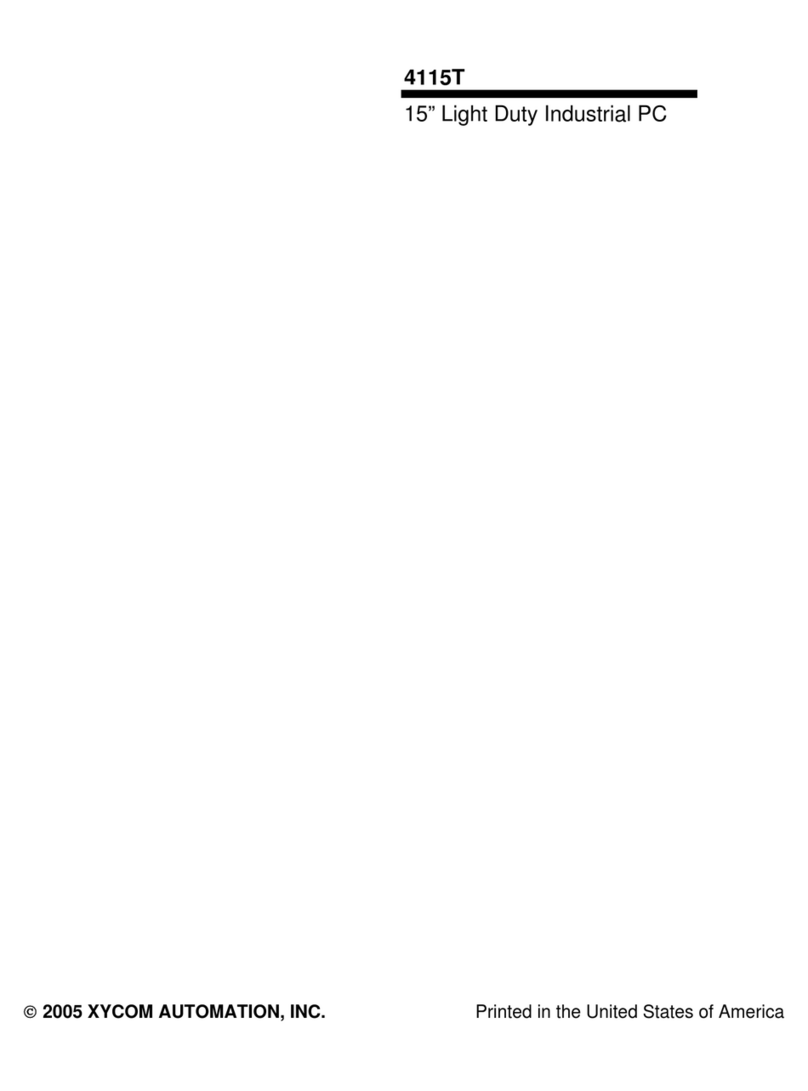
Xycom
Xycom 4115T user manual

ABB
ABB C6240 Installation and operating instructions
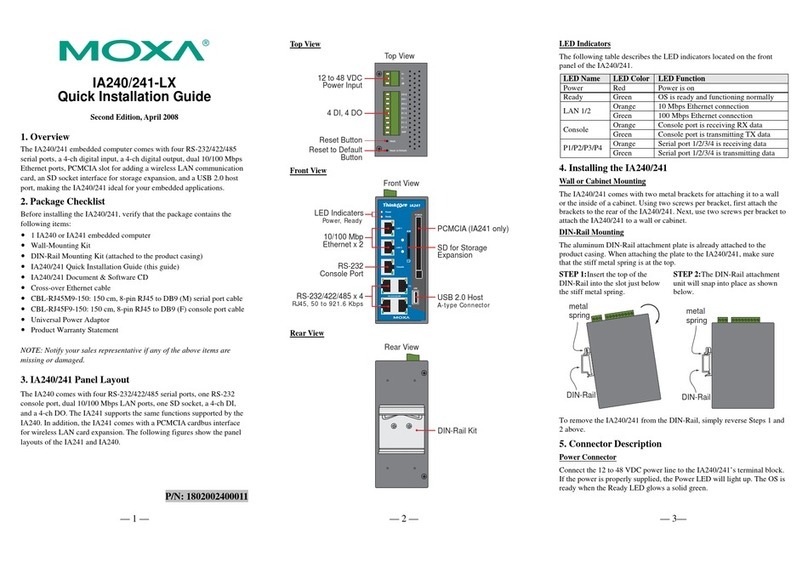
Moxa Technologies
Moxa Technologies IA240-LX Quick installation guide
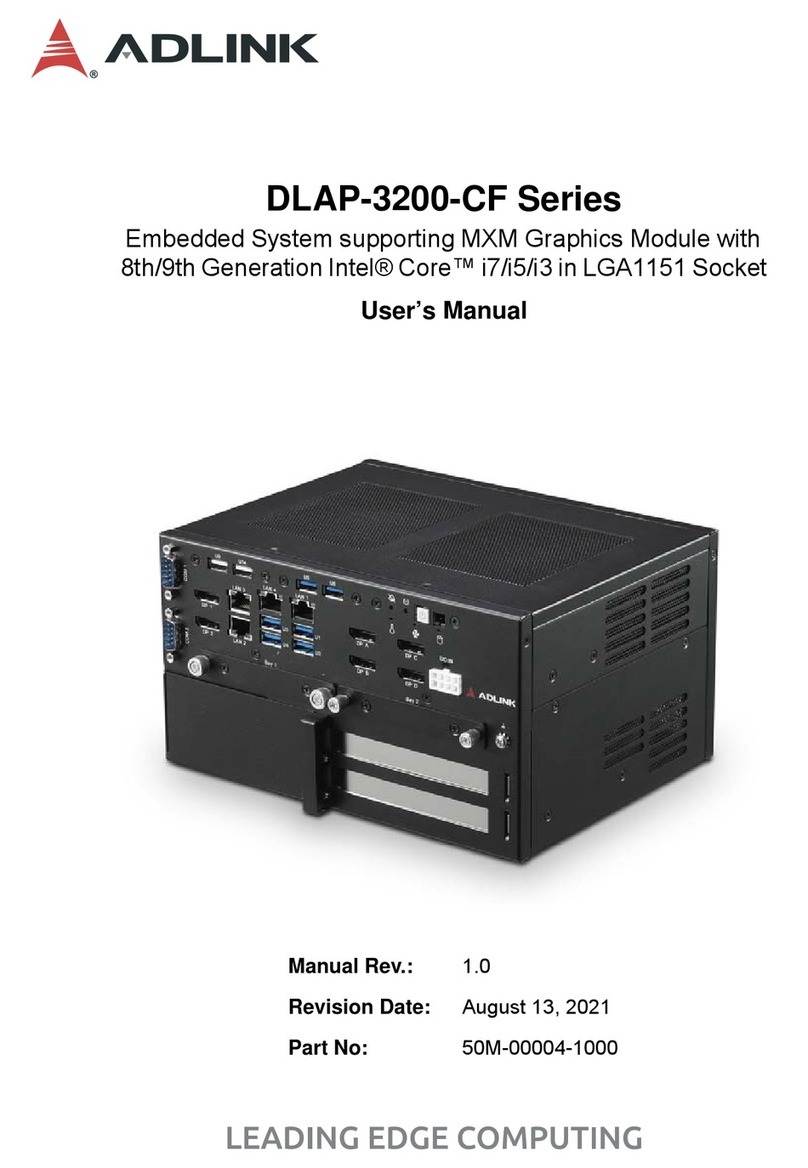
ADLINK Technology
ADLINK Technology DLAP-3200-CF Series user manual
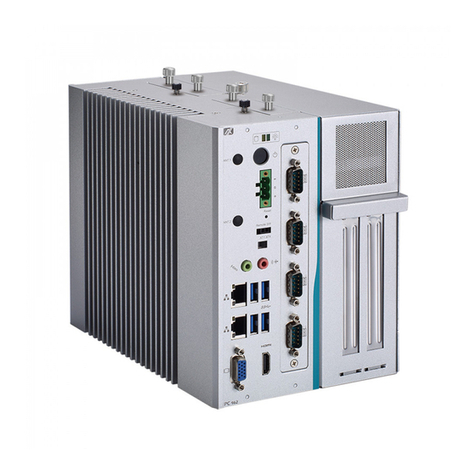
AXIOMTEK
AXIOMTEK IPC962-512-FL Series user manual
